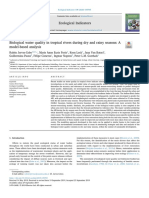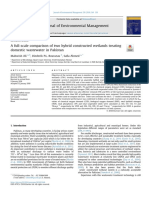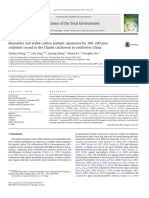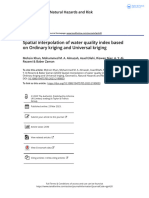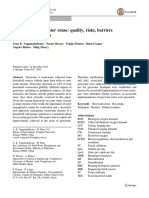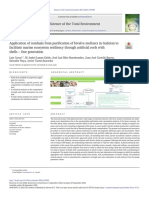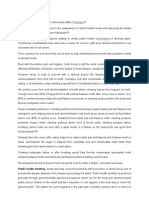Professional Documents
Culture Documents
Prediction of Piggery Wastewater Nutrient Attenuation by Constructed Wetland in A Humid Environment
Original Title
Copyright
Available Formats
Share this document
Did you find this document useful?
Is this content inappropriate?
Report this DocumentCopyright:
Available Formats
Prediction of Piggery Wastewater Nutrient Attenuation by Constructed Wetland in A Humid Environment
Copyright:
Available Formats
Volume 8, Issue 9, September – 2023 International Journal of Innovative Science and Research Technology
ISSN No:-2456-2165
Prediction of Piggery Wastewater Nutrient
Attenuation by Constructed Wetland in a Humid
Environment
I. J. Udom1, E. S. Udofia2, S. A. Nta1, G. A. Usoh 1, E. O. Sam1
1
Department of Agricultural Engineering, Akwa Ibom State University, Ikot Akpaden
2
Department of Mathematics, Akwa Ibom State University, Ikot Akpaden
Abstract:- A mathematical model for predicting the or treat it before discharge to the surroundings instead of
reduction of nitrogen and phosphorus concentrations in stockpiling them in drains and pond where it decomposes
horizontal subsurface flow constructed wetlands was and becomes part of the soil as is the case in Nigeria
developed. The model considered the piggery wastewater (Kadurumba and Kadurumber. 2019, Ewuziem et al., 2009)
input, storage, plant use and nutrient output to the Nutrients (nitrogen and phosphorus) are the pollutants of
environment is predominantly through nitrogen concern in pig wastewater to safeguard infants’ health and
denitrification. Nutrient release from plant litter was not nutrient enrichment of water because oxidation of
considered an influence on the constructed wetland ammonium to nitrate take as much as 4.3 g for each gram of
because the young plants were picked for fodder and, ammonium (Henze et al., (1995).
contamination from rainfall and groundwater was
considered insignificant. The adjustment and Similarly, Phosphorus modifies freshwater plant and
authentication of the model was carried out by separate algae development (EPA, 2000) and substantially regulate
data sets. Nutrient attenuation followed exponential downstream water quality (Wallace and Knight, 2006) and
trend during the period followed by stability contingent use (Gouriveau, (2009).
on the decay coefficient. Simulated parameters
correlated highly with the observed values with R= Satisfactory wastewater management in developing
0.8940 for nitrogen and 0.9518 for phosphorus countries is impeded by financial requirement (Muga and
respectively. ME of 0.211 and 0.139, RMSE of 0.32 and Mihelcic, 2008), for construction, maintenance and
0.18, RE of 24 and 12%, model efficiencies of 64 and upgrading and ignorance of cheap but effective and
37% and index of agreements of 0.6527 and 0.8676 for sustainable wastewater management due to the huge
nitrogen and phosphorus respectively. The linear investments necessary to construct, maintain and improve
regression coefficients appear good for a natural system wastewater treatment amenities, but it is also due to lack of
under environmental influences. information on developments in wastewater treatment
technologies and the use of low cost wastewater treatment
Keywords:- Piggery Wastewater, Horizontal-Subsurface- know-hows (Mburu et al., 2012).
Flow-Constructed-Wetlands, Pollution, Water Quality,
Nutrients. Treatment or constructed wetlands (CW) systems
deliberately attenuate nutrients by receiving, retaining and
I. INTRODUCTION processing nutrients by physico-chemical and biological
paths (Abbasi et al., 2019; Nandakumar et al., 2019) as
Pork is highly consumed and accounts for over 30% of wastewater gradually passes through the wetland. The above
world-wide meat demand (Modern technologies for raising paths account for an assortment of nutrient attenuation
pigs, 2015). In 2016, (Soare and Chiurciu, 2017), pork’s per through disintegration, uptake and transformation of
capita consumption was the highest in the world accounting nitrogenous composites. There are qualitative evidences to
for over 39% of meat consumed from all sources. Pig show that the wastewater depuration efficiency of
production is an important aspect of the livestock enterprise constructed wetlands but quantitative confirmations are
in Nigeria’s agriculture (Uddin and Osasogie, 2016). required for ecological conditions and system design
(Kadlec and Wallace 2009) necessary for appropriate
Nutrient pollution from large scale pig farms is the design, operation, feedbacks and improvement of CW
main concern in managing pig waste (Udom et al., 2018). systems in different situations. CW design has evolved from
Pig waste contains excessive nutrient that can negatively input-output empirical relationships to complex
impact on land, water and aquatic environments (Mason, relationships (Kadlec and Wallace, 2009) but, the problem
2002); and breeds pathogens, bacteria and heavy metals of approximating the numerous parameter interactions
which are harmful to human health (Wendee, 2017, Horton involved in pollutant removal process justify the rising
et al., 2009). Good waste control is inevitable to secure utilization of prediction models for the design of CW
sustainable environmental quality (ECC, 1999; EPA, 2000). (Kadaverugu, 2016). A prediction model describes the
The best approach to managing waste is to recycle the waste physical processes and boundaries of a system using one or
IJISRT23SEP408 www.ijisrt.com 2585
Volume 8, Issue 9, September – 2023 International Journal of Innovative Science and Research Technology
ISSN No:-2456-2165
more governing equations. Prediction models define the In this paper, we develop a prediction model for
connection among the model parameters and connect them piggery wastewater nutrient attenuation using a sub-surface
with between the model components and link them together horizontal flow CW. This study will be useful for CW
using precise mathematical balances (Jorgensen and development and application in pollution control.
Bendoricchio, (2001). FITOVERT (Giraldi et al., 2010),
HYDRUS 2D/3D (Simunek et al. 2008), PHWAT (Brovelli II. MATERIALS AND METHOD
et al. 2009) are examples of CW models with prediction
capabilities for intermittently inundated soils and pollutant A. Study Area and Project Location
fate but they are not freely available. STELLA is a dynamic The location of the horizontal subsurface flow
software program with wide application but is expensive for constructed wetland (HSSFCW) at the Obio Akpa campus
rural applications (Allen 2019). of Akwa Ibom State University (AKSU) is highlighted in
Figure 1. Obio Akpa is situated between longitudes 07o 3”E
and 07o 3”E and latitude 04o 45”N and 04o 55”N.
Fig 1 Location of Piggery and Constructed Wetlands.
Mean lowest and highest temperatures are between wetland basins were packed to 0.60 m depth with sharp-
18OC -27OC and 24OC - 36OC. A perennial stream is the sand and Pennisetum clandestinum (PC) was planted in two
main channel in the watershed with a population of over cells while the third cell was the control.
150,000 people (NPC, 2006). Relative humidity ranges
between 55-86% and average rainfall is between 2050 mm C. Sample Collection and Monitoring
to 2450 mm. Estimated untreated wastewater volume of 9.46 The wetland was monitored after three month's
m3/day is released on the floodplain. stabilization. Wastewater samples were collected at the inlet
before loading the CW and three days after at the outlet of
B. Experimental Setup the CW. The status of total nitrogen (TN) and total
The study was carried out at the Akwa Ibom State phosphorus (TP) were investigated (AOAC, 2007).
University. A (7 m x 1.75 m x 0.60 m) concrete CW having Destructive and systematic sampling techniques were
three wetland cells were created. A 2.5 mm thick Texclear adopted for the plants and the soil respectively. Nutrient
plastic liner covered the entire wetland floor. Both the attenuation was calculated from the differences in
wastewater inlet and outlet regions of the wetland basin wastewater concentrations before and after residence in the
were jam-packed up to 0.60 m depth with 30 mm crushed CW.
granite rock at a distance of one meter from each end. The
IJISRT23SEP408 www.ijisrt.com 2586
Volume 8, Issue 9, September – 2023 International Journal of Innovative Science and Research Technology
ISSN No:-2456-2165
E. Model Derivation
Equations derived based on the above assumptions
were:
Nitrogen
𝑑𝑁
= −𝜌 𝑁(𝑡) + 𝑓(𝑡) [2.1]
𝑑𝑡
𝑁(0) = 𝑁0 Where,
Fig 2 Theoretical Model of Nutrient Attenuation Process in N = nitrogen concentration (mg/l)
CW
𝜌 = CW nitrogen removal rate (mgd-1)
In Figure 2 the theoretical model of the nutrient
attenuation pathways for conversion of organic matter to 𝑑𝑁
ammonia and phosphate and consequent transportation, + 𝜌 𝑁(𝑡) = 𝑓(𝑡) [2.2]
retaining, use by plants and discharge (denitrification, 𝑑𝑡
volatilization, and burial) from the CW. The model divides By using integrating factor,
the CW into three simple partitions: (1) wastewater pool (2)
CW soil, and (3) CW plant. The CW water pool comprise 𝐼. 𝐹 = 𝑃(𝑡) = 𝜌
pig excess flow, organic nitrogen and phosphorus deposit.
Impact of pollutant input from the atmosphere is negligible
𝑒 ∫ 𝑃(𝑡)𝑑𝑡 = 𝑒 ∫ 𝜌𝑑𝑡 = 𝑒 𝜌𝑡
in CW. The site for nitrification of ammonium nitrogen is in
the aerobic part of the CW media and the water pool, while
Multiplying both sides of (2.2) by the integrating
nitrate attenuation is restricted to the anaerobic region in the
dynamic CW media and the root zone of CW macrophytes. factor, we have
Nitrogen is mainly lost to the atmosphere in conditions
𝑑𝑁
where the alkalinity is high (Reddy and Delaune, 2008). 𝑒 𝜌𝑡 ( + 𝜌 𝑁(𝑡)) = 𝑒 𝜌𝑡 𝑓(𝑡)
Ammonium ion oxidation in the water pool and oxidized 𝑑𝑡
media also produces nitrate.
𝑑
(𝑁𝑒 𝜌𝑡 ) = 𝑒 𝜌𝑡 𝑓(𝑡)
Phosphorus attenuation derives from deposition of 𝑑𝑡
suspended organic matter residue but then does not result in
𝑑(𝑁𝑒 𝜌𝑡 ) = 𝑒 𝜌𝑡 𝑓(𝑡)dt
gaseous losses. The physical routes of advection (inflow,
outflow), deposition, resuspension, and dispersion is also 𝑡 𝑡
applicable to phosphorus transportation and destiny in the ∫ 𝑑(𝑁𝑒 𝜌𝑠 ) = ∫ 𝑒 𝜌𝑠 𝑓(𝑠)𝑑𝑠
CW. Biologically available inorganic phosphorus (typically 0 0
orthophosphate) alone is easily reached by CW
𝑡
macrophytes. Phosphorus introduced to the CW from
𝑁(𝑡)𝑒 𝜌𝑡 − 𝑁0 = ∫ 𝑒 𝜌𝑠 𝑓(𝑠)𝑑𝑠
groundwater, sediment and runoff and breakdown of organic 0
matter are the main sources of inorganic phosphorus in CW
media and water pool. Apart from plant gathering, burial is 𝑡
nearly the single means for the attenuation of phosphorus in 𝑁(𝑡)𝑒 𝜌𝑡 = 𝑁0 + ∫ 𝑒 𝜌𝑠 𝑓(𝑠)𝑑𝑠
0
CW (Kadlec and Wallace, 2009).
Dividing through by 𝑒 𝜌𝑡
D. Model Assumptions
Assumptions considered in the derivation of the first 𝑡
order equations to describe the rate of nutrient attenuation in 𝑁(𝑡) = 𝑁0 𝑒−𝜌𝑡 + 𝑒 −𝜌𝑡 ∫ 𝑒 𝜌𝑠 𝑓(𝑠)𝑑𝑠 [2.3]
the CW were: 0
CW contains no initial nutrients. 𝑁(0) = 𝑁0 Suppose 𝑓(𝑡) ≡ 0, 𝑤ℎ𝑒𝑟𝑒 𝑓(𝑡) 𝑖𝑠 𝑡ℎ𝑒 𝑖𝑛𝑓𝑙𝑢𝑒𝑛𝑡, then
Nutrient introduction is periodical at the 𝑓(𝑡).
Nutrient concentration at time 𝑡 > 0 𝑖𝑠 𝑁(𝑡) 𝑁(𝑡) = 𝑁0𝑒 −𝜌𝑡 [2.4]
Plant use, retention in CW media, biogeochemical
process creates the nutrient attenuation avenues from the This is a first order differential equation with the initial
CW at the rate 𝜌 proportional to the quantity present. condition (background concentration) 𝑁(0) = 𝑁0
Nitrogen supply rate to the CW from precipitation is
The quantity of N nutrient in the CW is represented by
insignificant.
Supply to and from groundwater is zero..
IJISRT23SEP408 www.ijisrt.com 2587
Volume 8, Issue 9, September – 2023 International Journal of Innovative Science and Research Technology
ISSN No:-2456-2165
𝑡 𝐷
𝑁(𝑡) = 𝑁0 𝑒 −𝜌𝑡 + 𝑒 −𝜌𝑡 ∫ 𝑒 𝜌𝑠 𝑓(𝑠)𝑑𝑠 , 𝑎𝑡 𝑡 > 0 [2.5] 𝑁(𝑡) = 𝑁0𝑒 −𝜌𝑡 + ⌈1 − 𝑒 −𝜌𝑡 ⌉ (2.9)
0
𝜌
This decay exponential function tells us that as 𝑡 → ∞ This demonstrates that though the amount of nitrogen
the quantity of 𝑁(𝑡) decreases to zero (0) but not rapidly will decline in the CW, it will not be completely eradicated
because of the presence of the influent 𝑓(𝑡) from the CW but, there will still be some background
concentration within the CW. In practice, piggery
Assuming 𝑓(𝑡) ≡ 0, , wastewater is released into the CW at a given time period T.
Presuming that the initial influent is at a time = 0+ , then the
Then the attenuation of the nitrogen will be fast. From initial concentration is 𝑁(0+ ) = 𝐷.
experimental observation, we discover that the above
statement and reason does not represent reality. Hence, we Such that,
assume further that the introduction of nitrogen 𝑓(𝑡) = 𝐷
into the CW is at a constant quantity over a period of time, 𝑑𝑁
− 𝜌 𝑁(𝑡), 0 < 𝑡 < 𝑇, 𝑡ℎ𝑎𝑡 𝑖𝑠, 𝑡 ∈ (0, 𝑇) [2.10]
and then the model equation becomes 𝑑𝑡
𝑑𝑁 𝑁(0+ ) = 𝐷
= −𝜌 𝑁(𝑡) + 𝐷 [2.6]
𝑑𝑡
Then solving this, we have,
𝑁(0) = 𝑁0
𝑁(𝑡) = 𝐷𝑒 −𝜌𝑡 [2.11]
𝑑𝑁
+ 𝜌 𝑁(𝑡) = 𝐷 [2.7] Which means that, the concentration before the second
𝑑𝑡
influent is,
𝑁(0) = 𝑁0
𝑁(𝑇 −) = 𝐷𝑒 −𝜌𝑇 [2.12]
By still using the method of integrating factor to find the
solution of the above problem, The model for next influent, that is, 𝑇 ≤ 𝑡 ≤ 2𝑇 is
𝐼. 𝐹 = 𝑒 ∫ 𝑓𝑑𝑡 = 𝑒 𝜌𝑡 𝑑𝑁
= −𝜌 𝑁(𝑡), [2.13]
𝑑𝑡
Multiplying both sides of Equation (2.7) by the integrating
factor, we have 𝑁(0+ ) = 𝑁(𝑇 −) + 𝐷 = 𝐷 + 𝐷𝑒 −𝜌𝑟 ,
𝑑𝑁 𝑤ℎ𝑒𝑟𝑒,
𝑒 𝜌𝑡 ( + 𝜌 𝑁(𝑡)) = 𝑒 𝜌𝑡 𝐷
𝑑𝑡
𝑟 = 𝑡 − 𝑇, 𝑡 = 𝑇 + 𝑟
𝑑
(𝑁𝑒 𝜌𝑡 ) = 𝑒 𝜌𝑡 𝐷 𝑇 = loading interval (d)
𝑑𝑡
𝑑(𝑁𝑒 𝜌𝑡 ) = 𝑒 𝜌𝑡 𝐷dt 𝑡 = CW retention time (d)
𝑡 𝑡 Solving the above equation, we have
∫ 𝑑(𝑁𝑒 𝜌𝑠 ) = 𝐷 ∫ 𝑒 𝜌𝑠 𝑑𝑠
0 0
𝑁(𝑡) = (𝐷 + 𝐷𝑒 −𝜌𝑇 )𝑒 −𝜌(𝑡−𝑇) [2.14]
𝐷 𝜌𝑡
𝑁(𝑡)𝑒 𝜌𝑡 − 𝑁0 = ⌈𝑒 − 𝑒0⌉ 𝑁(2𝑇 −) = 𝐷(1 + 𝑒 −𝜌𝑇 )𝑒 −𝜌𝑇
𝜌
𝐷 𝜌𝑡 The concentration before the third influent is
𝑁(𝑡)𝑒 𝜌𝑡 = 𝑁0 + ⌈𝑒 − 1⌉
𝜌 𝑁(2𝑇 −) = 𝐷(1 + 𝑒 −𝜌𝑇 )𝑒 −𝜌𝑇
Dividing through by 𝑒 𝜌𝑡 The model for next influent, that is, 2𝑇 ≤ 𝑡 ≤ 3𝑇 is
𝐷 𝑑𝑁
𝑁(𝑡) = 𝑁0𝑒 −𝜌𝑡 + ⌈1 − 𝑒 −𝜌𝑡 ⌉ (2.8) = −𝜌 𝑁(𝑡),
𝜌 𝑑𝑡
The quantity of nitrogen that will remain in the system 𝑁(0+ ) = 𝑁(2𝑇 −) + 𝐷 [2.15]
at 𝑡 > 0 after a constant quantity 𝐷 has been introduced
into the system is represented by, = 𝐷(1 + 𝑒 −𝜌𝑇 + 𝑒 −2𝜌𝑇 ),
IJISRT23SEP408 www.ijisrt.com 2588
Volume 8, Issue 9, September – 2023 International Journal of Innovative Science and Research Technology
ISSN No:-2456-2165
𝑊ℎ𝑒𝑟𝑒,
𝑟 = 𝑡 − 2𝑇
𝑡 = 2𝑇 + 𝑟
Solving, we have
Fig 3 Nitrogen Sharing in Constructed CW
𝑁(𝑡) = 𝐷(1 + 𝑒 −𝜌𝑇 + 𝑒 −2𝜌𝑇 )𝑒 −𝜌(𝑡−2𝑇) [2.16] By applying the assumptions above, we get the
resulting mass balance equation
The concentration before the 4th influent is
𝒅𝑵
𝑁(3𝑇 −) = 𝐷(1 + 𝑒 −𝜌𝑇 + 𝑒 −2𝜌𝑇 )𝑒 −𝜌𝑇 = 𝑫 − 𝜹𝟐 𝑵(𝒕) − 𝜹𝟏 𝑵(𝒕) − 𝜶 𝑵(𝒕) − 𝜷𝑵(𝒕)
𝒅𝒕
− 𝜺𝑵(𝒕) [𝟐. 𝟐𝟎]
The general concentration before the nth influent is
From Equation (2.15), we collect all the constants
𝑁((𝑛 − 1)𝑇) = 𝐷(1 + 𝑒 −𝜌𝑇 + 𝑒 −2𝜌𝑇 together
+ 𝑒 −3𝜌𝑇 + . . . + 𝑒 −(𝑛−1)𝜌𝑇 )𝑒 −𝜌𝑇 [2.17]
𝑑𝑁
When making the nth influent, = 𝐷 − (𝛿2 + 𝛿1 + 𝛼 + 𝛽 + 𝜀)𝑁(𝑡) [2.21]
𝑑𝑡
𝑁(𝑛𝑇 +) = 𝑁((𝑛 − 1)𝑇) + 𝐷 [2.18] 𝐿𝑒𝑡 𝛾 = 𝛿2 + 𝛿1 + 𝛼 + 𝛽 + 𝜀
= 𝐷(1 + 𝑒 −𝜌𝑇 + 𝑒 −2𝜌𝑇 + 𝑒 −3𝜌𝑇 + . . . + 𝑒 −(𝑛−1)𝜌𝑇 ) Then
𝑒 −𝜌𝑇 𝑁(𝑛𝑇 +) = 𝐷(𝑒 −𝜌𝑇 + 𝑒 −2𝜌𝑇 𝑑𝑁
= 𝐷 − 𝛾𝑁(𝑡)
+ 𝑒 −3𝜌𝑇 + . . . + 𝑒 −(𝑛−1)𝜌𝑇 + 𝑒 −𝑛𝜌𝑇 ) 𝑑𝑡
𝑑𝑁
𝑁(𝑛𝑇 +) − 𝑒 −𝜌𝑇 𝑁(𝑛𝑇 +) = 𝐷( 1 − 𝑒 −𝜌𝑇 ) + 𝛾𝑁(𝑡) = 𝐷 [2.22]
𝑑𝑡
(1 − 𝑒 −𝜌𝑇 )𝑁(𝑛𝑇 +) = 𝐷( 1 − 𝑒 −𝜌𝑇 )
𝑁(0) = 𝑁0
𝐷( 1 − 𝑒 −𝜌𝑇 )
𝑁(𝑛𝑇 +) = Solving, we have the nitrogen removal model as,
1 − 𝑒 −𝜌𝑇
𝐷
𝐷 𝑁(𝑡) = 𝑁0 𝑒−𝛾𝑡 + ⌈1 − 𝑒 −𝛾𝑡 ⌉ [2.23]
lim 𝑁(𝑛𝑇 +) = [2.19] 𝛾
𝑛 → ∞ 1 − 𝑒 −𝜌𝑇
F. Summation of Nutrient Removal Sites Phosphorus
The above prediction model does divide nitrogen into Phosphorus attenuation model was obtained on the
the different partitions of the CW. To account for these same principles as nitrogen. The only difference the
partitions in the model, we assume further as below: partitioning of phosphorus which excludes loss to the
atmosphere as shown in the diagram below.
The nitrogen supply rate into the CW from precipitation
is insignificant,
Rate of nitrogen consumption by CW macrophyte is 𝛿2 ,
No loss to groundwater,
Rate of nitrogen discharge (effluent) from the system is
𝛼,
The rate of nitrogen supply into the CW is 𝐷
The rate of retention of nitrogen in the CW water pool is Fig 4 Phosphorus Partitioning in CW.
𝛿1
Based on the assumptions and the parameters above,
The rate of retention of nitrogen in the CW media is 𝜀
the model equation becomes
The rate of denitrification of nitrogen in the CW is 𝛽
𝑑𝑃
= 𝐷 − 𝑘𝑃; 𝑃(0) = 𝑃0
𝑑𝑡
Where 𝑘 = 𝛼1 + 𝛼2 + 𝛼3 + 𝛼4
D = input phosphorus concentration (mg/l)
IJISRT23SEP408 www.ijisrt.com 2589
Volume 8, Issue 9, September – 2023 International Journal of Innovative Science and Research Technology
ISSN No:-2456-2165
𝛼1 = CWplant use (mg/l) Root Mean Square Error (RMSE)
It quantifies the dispersion between simulated and
𝛼2 = accumulation in CW media and sediment (mg/l) measured data.
𝛼3 = retention in wetland water pool (mg/l) N
1
RMSE = √ ∑(Pi − Oi )2 [2.27]
𝛼4 = discharged phosphorus concentration (mg/l) N
i=1
Other variables are as defined for nitrogen. Relative Error (RE):
Hence, RMSE
RE = × 100 [2.28]
y̅
𝑑𝑃
+ 𝑘𝑃 = 𝐷 [2.24]
𝑑𝑡 Where,
𝑃(0) = 𝑃0 y is the mean of observed values.
Solving, we have the phosphorus removal model as Model Efficiency
Model efficiency (EF) was calculated as:
𝐷
𝑃(𝑡) = 𝑃0 𝑒 −𝑘𝑡 + ⌈1 − 𝑒 −𝑘𝑡 ⌉ [2.25]
𝑘 ̅ )2 − ∑(P − P
∑(O − O ̅)2
EF = ̅ )2 [2.29]
∑(O − O
G. Model Solutions
Solutions to the first order equations concerning the
Where,
nutrients attenuation in the CW were obtained by using
MATLAB approach. Consequently, standardization of ̅ = mean observed values;
O = observed values; O
model constants and verification of the model were carried
out using data obtained from the experiment. Finally, the
̅ = mean predicted values
P = predicted values and, P
model was validated by comparing field values with model
predictions.
Index of Agreement (IA):
H. Evaluation of Model Performance
The model was evaluated statistically to indicate its ∑Ni=1(Oi − Pi )
2
d= 1− ,0 ≤ d ≤ 1 [2.30]
performance. evaluated (Fox, 1981). ∑N ′ ′ 2
i=1(O i + P i )
Bias or Mean Bias Where O’i = |Oi - P| , P’i = |Pi -P | , Oi is the observed
N
value, Pi is the simulated value and P is the simulated mean.
1 d = 1corresponds to a perfect match of predicted to observed
ME = ∑(Pi − Oi ) [2.26] data.
N
i=1
I. Model Calibration
Where P and O are the predicted and observed values and N Model calibration parameters for nitrogen and
is the number of observations. phosphorus removal respectively, are presented in Table 1
Table 1 Parameters for Calibration of Nitrogen and Phosphorus Removal.
Symbols Description N P Unit
𝑁0 Initial concentration of Nitrogen 6.00 mg/l
𝑃0 Initial concentration of Phosphorus 2.23 mg/l
𝑡 Retention time 3 3 Days
𝜌 Rate of Nutrient removal from the wetland system. 0.122 0.078 m3/day
𝐷 Input rate (mean) 29.2 11.52 m3/day
𝑇 Period time of introducing nutrient. 3 3 Days
𝛿1 Nutrient retention in wetland water column 1.48 mg/l
𝛿2 Plant Nutrient uptake 8.90 mg/l
𝛽 Denitrification (52% of net N input) 15.2 mg/l
𝜀 Nutrient retention in wetland sediment 5.05 mg/l
𝛼𝑁 Effluent rate or output 2.07 m3/day
𝛼1 Plant uptake 2.08 mg/l
𝛼2 Nutrient retention in wetland sediment 2.87 mg/l
𝛼3 Retention in wetland water column 2.01 mg/l
𝛼4 Effluent rate 1.24 mg/l
IJISRT23SEP408 www.ijisrt.com 2590
Volume 8, Issue 9, September – 2023 International Journal of Innovative Science and Research Technology
ISSN No:-2456-2165
To calibrate the model, field data collected within February – April, 2018 were used. The procedure was to adjust the model
parameters and forcing within the boundaries of the uncertainties to get a model representation of the processes of interest that
satisfies pre-agreed conditions.
J. Model Validation
Input parameters for model simulation are shown in Table 2.
Table 2 Parameters for Model Simulation for Nitrogen and Phosphorus Attenuation.
Symbols Description N P Unit
𝑁0 Initial concentration of Nitrogen 6.06 mg/l
𝑃0 Initial concentration of Phosphorus 2.23 mg/l
𝑡 Retention time 3 3 Days
𝜌 Rate of Nutrient removal from the wetland system. 0.125 0.082 md-1
𝐷 Input rate (mean) 27.40 10.21 m3/day
𝑇 Period time of introducing nutrient. 3 3 Days
𝛿1 Nutrient retention in wetland water column 1.28 mg/l
𝛿2 Plant Nutrient uptake 8.76 mg/l
𝛽 Denitrification (52% of net N input) 5.82 mg/l
𝜀 Nutrient retention in wetland sediment 5.65 mg/l
𝛼𝑁 Effluent rate or output 1.28 m3/day
𝛼1 Plant uptake 2.43 mg/l
𝛼2 Nutrient retention in wetland sediment 2.81 mg/l
𝛼3 Retention in wetland water column 1.71 mg/l
𝛼4 Effluent rate 0.96 mg/l
The simulation of the prediction model was effected by CW are presented in Figures 6 and 9 respectively. There was
comparing the field data with the model prediction by a high degree of relationship between the simulated and
plotting the simulated and field data against time after observed values.
running a calibrated model with a new set of data
(independent data set) with physical parameters and the
derived functions to reflect new conditions and discover
how well the model simulations fit the new data set.
III. RESULTS AND FINDINGS
Model simulation Results
Simulations of nutrient attenuation in the CW were
executed using the parameters shown in Table 2 to define
the overall relations and connections that influence the
attenuation of nitrogen and phosphorus in CW. The model
simulations after introducing mathematical equations,
parameters and initial conditions in the state variables are
presented in Figures 5 and 6.
Fig 6 Correlation of Observed and Simulated Attenuation of
Nitrogen in Constructed Wetland.
Fig 5 Simulated and Observed Nitrogen Attenuation in CW.
The relationship amongst the simulated and observed Fig 7 Simulated and Observed Variations for Phosphorus
attenuation of nitrogen and phosphorus contaminants in the Removal in CW
IJISRT23SEP408 www.ijisrt.com 2591
Volume 8, Issue 9, September – 2023 International Journal of Innovative Science and Research Technology
ISSN No:-2456-2165
The correlation between the simulated and observed pigs. Nitrogen release to the atmosphere is primarily through
attenuation of phosphorus in the CW is presented in Figure denitrification of nitrogen. Contamination from rainfall and
9. There was high correlation among the simulated and interchange with subsurface are insignificant matched with
observed values. other processes.
In the research, nitrogen and phosphorus attenuation
was exponential in the first three days of detention of the
wastewater in the CW and thereafter the attenuation was
constant at greater detention periods contingent on the decay
constant. The CW design was centered on first order plug
flow reaction that is characterized by decay response
indicating a weakening in contaminant strength along the
CW basin as long as the strength of the entering wastewater
exceed that of the CW. This remark is compatible with that
of Kadlec and Wallace (2009) for a number of CW. The
relationship among the observed and simulated attenuation
rates removal for N and P in Figures 6 and 8 indicated good
agreement as presented by regression equations in Figures 6
for N (R = 0.9537) and Figure 8 for P (R = 0.9912)
separately.
Fig 8 Correlation of Observed and Simulated Removal of The linear regression coefficients are very good agreed
Phosphorus in CW that the CW was a natural system sited in the field, where
unrestrained impelling influences might wane optimum
IV. DISCUSSION ON FINDINGS efficiency according to Jørgensen and Bendoricchio, (2001).
A. Process Model Assumptions and Development B. Statistical Indicators of Model Performance
In this model, nutrient discharge due to plant die-off The statistical pointers of model performance are
was not considered to have an input into the wetland since shown in Table 3.
the macrophytes are likely to be mowed fresh to feed the
Table 3 Statistical Pointers of Model Performance
Nutrient R2 R Mean bias Root Mean Square Relative Model efficiency Index of
error (mm) Error (mm) Error (%) (%) Agreement
Nitrogen 0.9537 0.9766 0.211 0.32 24 84 0.6527
Phosphorus 0.9912 0.9956 0.139 0.18 12 77 0.8676
The statistical pointers of simulation performance are and also in the field data. For instance, the model adopts the
summarized in Table 3. The rate of coefficient of steady-state situation but in reality, this may not be true (as
determination (R2, 0.9537, 0.9912) indication that a good the flux can vary with the change in moisture level and
relationship exists between observed and simulated values atmospheric demand). Overload of phosphorus in the
for both Nitrogen and Phosphorus separately. The wetland bed and /or low bed porousness of the parent
proportion of mean bias error (MBE) is equivalent to 0.21 material used for bed construction could prejudice
and 0.14 mm for both nitrogen and phosphorus separately. A phosphorus attenuation efficiency as observed by
positive rate of MBE shows excessive estimation and vice- Karczmarczyk (2004).
versa. The mean root square errors are 0.32 and 0.18 mm for
both nitrogen and phosphorus. The extent of root mean C. Model Applications and Limitations
square error (RMSE) is a suitable parameter of model The models developed in this study are suitable for
performance. In an ideal situation, the rate of relative error performance analysis of horizontal subsurface flow
(RE) and the model efficiency (EF) will be 0% and 100%, constructed wetlands getting secondary piggery wastewater.
separately. So the RE value of about 24 and 12 % and EF Their application requires information on inflow wastewater
value of about 64 and 37 % obtained in this study show that concentrations (mg/l) of organic nitrogen and phosphorus in
the strength of model in predicting real life attenuation of the wetland and the inflow rate. The initial values of
the nutrients was good for nitrogen and reasonable for nitrogen and phosphorus in the soil and in the wastewater
phosphorus. The limit of index of agreement (d) value is are also required (Udom, 2023).
from 0 to 1. A higher value indicates a better agreement
between the simulated and observed values. In this study,
the value of d (0.6527 and 0.8676) indication a good
performance of the model in attenuating the nutrients.
However, much departure from the ideal value for the model
may be owing to in-built assumptions in the model code,
IJISRT23SEP408 www.ijisrt.com 2592
Volume 8, Issue 9, September – 2023 International Journal of Innovative Science and Research Technology
ISSN No:-2456-2165
REFERENCES [17]. C. Mason. "Biology of Freshwater Pollution". Fourth
Edition. Pearson Educational Ltd, Edinburg Gate,
[1]. H. N. Abbasi, J. Xie, S.I. Hussain, X. Lu. “Nutrient Harlow, Essex, Uk. 2002.
removal in hybrid Constructed Wetlands: spatial- [18]. "Modern technologies for raising pigs" 2015. Available
seasonal variation and the effect of vegetation”. Water at:https://gazetadeagricultura.info/animale/porcine/174
Science and Technology., vol.79 issue 10. pp 1985– 66-tehnologii-moderne-pentru-cresterea-porcilor. html.
1994, 2019 [19]. H. F. Muga, R. Mihelcic. "Sustainability of wastewater
[2]. A. Karczmarczyk. “Phosphorus removal from treatment technologies". Journal of Environmental
domestic wastewater in horizontal subsurface flow Management vol. 88 issue 3 pp. 437- 447, 2008.
constructed wetland after 8 years of operation – a case [20]. Mburu N., R.D.L Rousseau., J. J. A. van-Bruggen and
study” Journal of Environmental Engineering and P.N.L Lens. "Potential of Cyperus Payrus Macrophyte
Landscape Management, vol.12 issue 4. Pp 126-131, for wastewater treatment: A review". 12th International
2004. Conference on Wetland systems for water pollution.
[3]. Allen, H. Private communication. 2019. AOAC. Central Venice (Italy) 4th – 9th October, 2012.
“Official methods of analysis. Association of Official [21]. S. Nandakumar, H. Pipil, S. Ray, A. K. Haritash.
Analytical Chemists”. Washington. 2007. 2019. Removal of phosphorous and nitrogen from
[4]. Brovelli, A., F. Malaguella, D.A. Bary. “Bioclogging wastewater in Brachiaria-based constructed wetland.
in porous media: Model development and sensitivity to Chemosphere. vol. 233 pp. 216-222, 2019.
initial conditions”. Environmental Modelling and [22]. NPC. National Population Commission, Abuja,
Software. vol. 24 issue 5. pp 611-626, 2009. Nigeria, 2006.
[5]. ECC. “Effluent Management Guidelines for Intensive [23]. K. A. Reddy, R. D. Delaune. "Biogeochemistry of
Piggeries in Australia” Australian and New Zealand Wetlands: Science and Applications". CRC Press.
Environment and Conservation Council, 1999. Boca Raton, FL., 2008.
[6]. EPA.“Constructed Wetlands Treatment of Municipal [24]. E. Soare, and I. Chiurciu. "Study on the pork market
Wastewaters”. United States Environmental Protection worldwide". Management, Economic Engineering in
Agency, 2000. Agriculture and Rural Development. 17(4): 321-326,
[7]. EPA. 2000. “Alternative Systems for Piggery Effluent 2017.
Treatment”. Available: http://www.epa.sa.gov.au/. [25]. S. J. Simunek, M. Th. Van Genuchten, M. Sejna. 2010.
[8]. J. E. Ewuziem, A.C. Nwosu, E.C.C. Amaechi, A. O. "Developments and applications of the HYDRUS and
Aniebo and P. O. Anyaebu. "Piggery waste STANMOD software packages and related codes".
management and profitability of pig farming in Imo Vadoze Zone Journal vol. 7 pp. 587-600, 2010.
State, Nigeria". Nigerian Agricultural Journal vol 4 [26]. I. O. Uddin and D.I. Osasogie. "Constraints of pig
issues 1-2 pp 42 – 53, 2009. production in Nigeria: A case study of Edo central
[9]. D. Giraldi D, M. de Michieli Vitturi, R. Iannelli. Agricultural Zone of Edo State". Asian Research
"Fitovert: a dynamic numerical model of subsurface Journal of Agriculture vol. 2 issu 4 pp 1-7, 2016.
vertical flow constructed wetlands".Environmental [27]. I. J. Udom. “Partitioning nutrients cycling in a
Modeling Software vol. 25 issue 5 pp. 633–640, 2010. constructed subsurface wetland treating piggery
[10]. F. Gouriveau. "Constructed farm wetland designed for wastewater for pollution control”. Arid Zone Journal of
remediation of Farmyard runoff: an evaluation of their Engineering, Technology & Environment vol. 19 issue
water treatment efficiency, ecological value, costs and 3 pp 17-29, 2023.
benefits". PhD Thesis – University of Edinburg, 2009. [28]. I. J. Udom, C. C. Mbajiorgu, E. O. Oboho.
[11]. Henze, M., P. Harremoes, J.L.C Jansen., and E. Arvin. "Development and Evaluation of a Constructed Pilot-
“Wastewater Treatment: Biological and Chemical Scale Horizontal Subsurface Flow Wetland Treating
Processes”. Springer, Verlag, Berlin, Germany, 1995. Piggery Wastewater for Pollution Control. Ain Shams
[12]. R. A. Horton, S. Wing, S.W. Marshall, K.A. Engineering Journal vol. 9 pp. 3179–3185, 2018.
Brownchery. "Malodour as trigger of stress and [29]. S. D. Wallace, and R.L. Knight. "Small-scale
negative mood in neighbours of hog operations". constructed wetland treatment systems: Feasibility,
American Journal of Public Health vol. 99 issue 3 pp design criteria, and O & M requirements". Final report,
610-615, 2009. Project 01-CTS. Water Environment Research
[13]. S. E. Jørgensen, and G. Bendoricchio. "Fundamentals Foundation (WERF). Alexandria. Virginia. 2006.
of ecological modelling". Elsevier. [30]. S. Wendee. “Intensive livestock operations, health and
[14]. R. H. Kadlec ., S.D. Wallace. "Treatment Wetlands". quality of life among Eastern Carolina residents”.
2nd Edition; CRC Press Boca, Raton FL, USA. 2009. Environmental Health Perspectives vol. 108 issue 3 pp
[15]. C. Kadurumba, M.E. Kadurumber. Piggery waste 233-238, 2017.
management practices and environmental implications
on Human health in Rivers State, Nigeria.
International Journal of Agric. and rural development.
22(1): 4161– 4166), 2019
[16]. R. Kadaverugu. "Modeling of subsurface horizontal
flow constructed Wetlands using OpenFOAM_Mode".
Earth Syst. Environ. vol. 2 pp. 55-65, 2016.
IJISRT23SEP408 www.ijisrt.com 2593
You might also like
- Building the Climate Change Resilience of Mongolia’s Blue Pearl: A Case Study of Khuvsgul Lake National ParkFrom EverandBuilding the Climate Change Resilience of Mongolia’s Blue Pearl: A Case Study of Khuvsgul Lake National ParkNo ratings yet
- Nitrogen RemovalDocument11 pagesNitrogen RemovalRamani Bai V.No ratings yet
- Treatment of Tertiary Hospital WastewaterDocument4 pagesTreatment of Tertiary Hospital WastewaterNovalina Annisa YudistiraNo ratings yet
- Water PollutionDocument10 pagesWater Pollutiongabriel muthamaNo ratings yet
- Parameterization and Comparison of The AquaCrop and MOPECO Models ForDocument14 pagesParameterization and Comparison of The AquaCrop and MOPECO Models ForLuciano Quezada HenriquezNo ratings yet
- Ecological Indicators: SciencedirectDocument29 pagesEcological Indicators: SciencedirectOmar Galindo BustincioNo ratings yet
- Ecological Ditch System For Nutrient Removal of Rural Domestic Sewage in The Hilly Area of The Central Sichuan Basin, ChinaDocument11 pagesEcological Ditch System For Nutrient Removal of Rural Domestic Sewage in The Hilly Area of The Central Sichuan Basin, Chinarober muñozNo ratings yet
- Science of The Total Environment: J.M. González I. de Guzmán, A. Elosegi, A. LarrañagaDocument10 pagesScience of The Total Environment: J.M. González I. de Guzmán, A. Elosegi, A. Larrañagajose alvarez garciaNo ratings yet
- Investigation Into The Kinetics of Constructed Wetland Degradation Processes As A Precursor To Biomimetic DesignDocument11 pagesInvestigation Into The Kinetics of Constructed Wetland Degradation Processes As A Precursor To Biomimetic DesignMuna AzizNo ratings yet
- Optimizing Nutrient Removal in Municipal Wastewater Under Microalgal-Bacterial Symbiosis With Mesh Screen SeparationDocument8 pagesOptimizing Nutrient Removal in Municipal Wastewater Under Microalgal-Bacterial Symbiosis With Mesh Screen SeparationSofiya213No ratings yet
- Perdana 2018 IOP Conf. Ser. Earth Environ. Sci. 148 012025Document10 pagesPerdana 2018 IOP Conf. Ser. Earth Environ. Sci. 148 012025Luis OlvaresNo ratings yet
- Cita 5 MCDocument7 pagesCita 5 MCMichael CaiminaguaNo ratings yet
- Hec-Hms Model For Runoff Simulation in Ruiru Reservoir WatershedDocument7 pagesHec-Hms Model For Runoff Simulation in Ruiru Reservoir WatershedAJER JOURNALNo ratings yet
- Iden 8Document6 pagesIden 8Qori Diyah FatmalaNo ratings yet
- Comparative Life Cycle Assessment of Rainbow Trout Oncorhynchus Mykiss Farming at Two Stocking Densities in A Low Tech Aquaponic System Francesco Bordignon Full ChapterDocument33 pagesComparative Life Cycle Assessment of Rainbow Trout Oncorhynchus Mykiss Farming at Two Stocking Densities in A Low Tech Aquaponic System Francesco Bordignon Full Chapterlisa.tyree749100% (6)
- Analysis of Ambo Water Supply Source Diversion ReducedsizeDocument22 pagesAnalysis of Ambo Water Supply Source Diversion ReducedsizekshambelmekuyeNo ratings yet
- Composite Filter For Treatment of Hydrocarbon Contaminated WatersDocument8 pagesComposite Filter For Treatment of Hydrocarbon Contaminated WatersInternational Journal of Innovative Science and Research TechnologyNo ratings yet
- The Effect of Dams On River Transport of Microplastic PollutionDocument7 pagesThe Effect of Dams On River Transport of Microplastic PollutionjennyferNo ratings yet
- Paper 6Document12 pagesPaper 6Atom Chia BlazingNo ratings yet
- Treatment of Domestic Wastewater Using A Lab-Scale Activated SludgeDocument4 pagesTreatment of Domestic Wastewater Using A Lab-Scale Activated SludgeRabialtu SulihahNo ratings yet
- Reuse of Wastewater For Irrigation Purposes - JBES 2021 by INNSPUBDocument12 pagesReuse of Wastewater For Irrigation Purposes - JBES 2021 by INNSPUBInternational Network For Natural SciencesNo ratings yet
- Domestic Waste PakistanDocument10 pagesDomestic Waste Pakistanjkem_fontanilla5425No ratings yet
- Science of The Total EnvironmentDocument11 pagesScience of The Total EnvironmentKenya NunesNo ratings yet
- Ouedraogo2019 Article ValidatingAContinental-scaleGrDocument15 pagesOuedraogo2019 Article ValidatingAContinental-scaleGrJessikaNo ratings yet
- Micro NanobubblewateroxygationsynergisticallyiDocument9 pagesMicro NanobubblewateroxygationsynergisticallyiAshish SonawaneNo ratings yet
- Groundwater Exploration Using 1D and 2D Electrical Resistivity MethodsDocument9 pagesGroundwater Exploration Using 1D and 2D Electrical Resistivity MethodsAhmad ImamNo ratings yet
- Investigating Root Architectural Differences in LiDocument14 pagesInvestigating Root Architectural Differences in LiCamilla EmanuellaNo ratings yet
- Science of The Total Environment: Yanhua Wang, Hao Yang, Jixiang Zhang, Meina Xu, Changbin WuDocument10 pagesScience of The Total Environment: Yanhua Wang, Hao Yang, Jixiang Zhang, Meina Xu, Changbin WuFabio Galvan GilNo ratings yet
- A Review of GIS-integrated Statistical Techniques For GroundwaterDocument30 pagesA Review of GIS-integrated Statistical Techniques For GroundwaterddNo ratings yet
- Science of The Total EnvironmentDocument9 pagesScience of The Total EnvironmentLaura Ximena Huertas RodriguezNo ratings yet
- Hydro - Geochemical and Geoelectrical Investigation of MUBI and Its Environs in Adamawa State, Northeastern NigeriaDocument12 pagesHydro - Geochemical and Geoelectrical Investigation of MUBI and Its Environs in Adamawa State, Northeastern NigeriaAnonymous lAfk9gNPNo ratings yet
- Accepted Manuscript: Journal of The Saudi Society of Agricultural SciencesDocument15 pagesAccepted Manuscript: Journal of The Saudi Society of Agricultural SciencesTimotius Candra KusumaNo ratings yet
- PattnaikYostPorterMasunagaAttanandana MSLDocument10 pagesPattnaikYostPorterMasunagaAttanandana MSLRhyanPrajaNo ratings yet
- Sedimentation Dynamics of Soil Particles in Sylvopastoral Half-Moons On Restored Plateaus in The Ouallam Department (Niger)Document11 pagesSedimentation Dynamics of Soil Particles in Sylvopastoral Half-Moons On Restored Plateaus in The Ouallam Department (Niger)Mamta AgarwalNo ratings yet
- 1 s2.0 S0301479723015372 MainDocument11 pages1 s2.0 S0301479723015372 MainFirginawan Surya WandaNo ratings yet
- Spatial Interpolation of Water Quality Index Based On Ordinary Kriging and Universal KrigingDocument17 pagesSpatial Interpolation of Water Quality Index Based On Ordinary Kriging and Universal KrigingasadellahiNo ratings yet
- EwijstDocument18 pagesEwijstRishabh GuptaNo ratings yet
- Comparison of Different Methods For Bathymetric Survey and SedimentationDocument16 pagesComparison of Different Methods For Bathymetric Survey and SedimentationCRISTINA QUISPE100% (1)
- Ecological Indicators: SciencedirectDocument16 pagesEcological Indicators: Sciencedirectshinta naurahNo ratings yet
- Water Balance: Case Study of A Constructed Wetland As Part of The Bio-Ecological Drainage SystemDocument6 pagesWater Balance: Case Study of A Constructed Wetland As Part of The Bio-Ecological Drainage SystemDhianRhanyPratiwiNo ratings yet
- BU UkahDocument13 pagesBU UkahElizabeth FigueroaNo ratings yet
- Applicability of Using Reverse Osmosis Membrane Te PDFDocument13 pagesApplicability of Using Reverse Osmosis Membrane Te PDFHatem Abu HamedNo ratings yet
- Vuppaladadiyam2019 Article AReviewOnGreywaterReuseQualityDocument23 pagesVuppaladadiyam2019 Article AReviewOnGreywaterReuseQualityVIVIANA ANDREA GARCIA ROCHANo ratings yet
- M3.11-1 WaterFootprint Cotton Chapagain Et Al 2006 PDFDocument18 pagesM3.11-1 WaterFootprint Cotton Chapagain Et Al 2006 PDFjhampolrosalesNo ratings yet
- Fmars 09 872077Document15 pagesFmars 09 872077Omotola MartinsNo ratings yet
- 10 0000@periodicos Ufpb Br@ojs2@juee@31294Document10 pages10 0000@periodicos Ufpb Br@ojs2@juee@31294Андрэй КазлоўNo ratings yet
- Comparison of International Standards For Irrigatio - 2022 - Agricultural WaterDocument15 pagesComparison of International Standards For Irrigatio - 2022 - Agricultural WaterDana MateiNo ratings yet
- Evaluacion de La Laguna de Fitofiltracion Con Pistia StratiotesDocument8 pagesEvaluacion de La Laguna de Fitofiltracion Con Pistia StratiotesGuillermo IdarragaNo ratings yet
- Application of Residuals From Purification of Bivalve Mollu 2023 Science ofDocument16 pagesApplication of Residuals From Purification of Bivalve Mollu 2023 Science ofcatrionaNo ratings yet
- Ma 2021Document12 pagesMa 2021Essekhyr HassanNo ratings yet
- Model Analysis of Check Dam Impacts On LDocument13 pagesModel Analysis of Check Dam Impacts On LJanhavi JoshiNo ratings yet
- A Paddy Eco-Ditch and Wetland System To Reduce Non-Point Source Pollution From Rice-Based Production System While Maintaining Water Use EfficiencyDocument22 pagesA Paddy Eco-Ditch and Wetland System To Reduce Non-Point Source Pollution From Rice-Based Production System While Maintaining Water Use EfficiencyRaudhatulUlfaNo ratings yet
- Groundwater Exploration Using 1D and 2D Electrical Resistivity MethodsDocument10 pagesGroundwater Exploration Using 1D and 2D Electrical Resistivity Methodsrizal montazeriNo ratings yet
- Detecting Temporal Changes in The Extent of Annual Flooding Within The RahulDocument19 pagesDetecting Temporal Changes in The Extent of Annual Flooding Within The Rahul19CV049 Prasanna Kumar MNo ratings yet
- The Hydrogeochemical Signatures Quality Indices AnDocument19 pagesThe Hydrogeochemical Signatures Quality Indices AnUnigwe Chinanu OdinakaNo ratings yet
- Measuring The Environmental Impacts of Sewage Sludge Use - 2023 - Science of TheDocument11 pagesMeasuring The Environmental Impacts of Sewage Sludge Use - 2023 - Science of TheDana MateiNo ratings yet
- 10 1016@j Ecoleng 2018 12 034Document9 pages10 1016@j Ecoleng 2018 12 034Dany AguilarNo ratings yet
- 1 s2.0 S0925857424000429 MainDocument10 pages1 s2.0 S0925857424000429 Mainarthagarwal09No ratings yet
- Uribe N. Spatio-Temporal Critical Source Areas PatternsDocument14 pagesUribe N. Spatio-Temporal Critical Source Areas PatternsnataliaNo ratings yet
- Biological Nutrient Removal by Recirculating Aquaponic SystemDocument9 pagesBiological Nutrient Removal by Recirculating Aquaponic SystemJesus Jimenez SaenzNo ratings yet
- Application of Game Theory in Solving Urban Water Challenges in Ibadan-North Local Government Area, Oyo State, NigeriaDocument9 pagesApplication of Game Theory in Solving Urban Water Challenges in Ibadan-North Local Government Area, Oyo State, NigeriaInternational Journal of Innovative Science and Research TechnologyNo ratings yet
- Exploring the Post-Annealing Influence on Stannous Oxide Thin Films via Chemical Bath Deposition Technique: Unveiling Structural, Optical, and Electrical DynamicsDocument7 pagesExploring the Post-Annealing Influence on Stannous Oxide Thin Films via Chemical Bath Deposition Technique: Unveiling Structural, Optical, and Electrical DynamicsInternational Journal of Innovative Science and Research TechnologyNo ratings yet
- Osho Dynamic Meditation; Improved Stress Reduction in Farmer Determine by using Serum Cortisol and EEG (A Qualitative Study Review)Document8 pagesOsho Dynamic Meditation; Improved Stress Reduction in Farmer Determine by using Serum Cortisol and EEG (A Qualitative Study Review)International Journal of Innovative Science and Research TechnologyNo ratings yet
- Detection of Phishing WebsitesDocument6 pagesDetection of Phishing WebsitesInternational Journal of Innovative Science and Research TechnologyNo ratings yet
- A Study to Assess the Knowledge Regarding Teratogens Among the Husbands of Antenatal Mother Visiting Obstetrics and Gynecology OPD of Sharda Hospital, Greater Noida, UpDocument5 pagesA Study to Assess the Knowledge Regarding Teratogens Among the Husbands of Antenatal Mother Visiting Obstetrics and Gynecology OPD of Sharda Hospital, Greater Noida, UpInternational Journal of Innovative Science and Research TechnologyNo ratings yet
- The Impact of Music on Orchid plants Growth in Polyhouse EnvironmentsDocument5 pagesThe Impact of Music on Orchid plants Growth in Polyhouse EnvironmentsInternational Journal of Innovative Science and Research Technology100% (1)
- Sustainable Energy Consumption Analysis through Data Driven InsightsDocument16 pagesSustainable Energy Consumption Analysis through Data Driven InsightsInternational Journal of Innovative Science and Research TechnologyNo ratings yet
- Esophageal Melanoma - A Rare NeoplasmDocument3 pagesEsophageal Melanoma - A Rare NeoplasmInternational Journal of Innovative Science and Research TechnologyNo ratings yet
- Vertical Farming System Based on IoTDocument6 pagesVertical Farming System Based on IoTInternational Journal of Innovative Science and Research TechnologyNo ratings yet
- Mandibular Mass Revealing Vesicular Thyroid Carcinoma A Case ReportDocument5 pagesMandibular Mass Revealing Vesicular Thyroid Carcinoma A Case ReportInternational Journal of Innovative Science and Research TechnologyNo ratings yet
- Influence of Principals’ Promotion of Professional Development of Teachers on Learners’ Academic Performance in Kenya Certificate of Secondary Education in Kisii County, KenyaDocument13 pagesInfluence of Principals’ Promotion of Professional Development of Teachers on Learners’ Academic Performance in Kenya Certificate of Secondary Education in Kisii County, KenyaInternational Journal of Innovative Science and Research Technology100% (1)
- Consistent Robust Analytical Approach for Outlier Detection in Multivariate Data using Isolation Forest and Local Outlier FactorDocument5 pagesConsistent Robust Analytical Approach for Outlier Detection in Multivariate Data using Isolation Forest and Local Outlier FactorInternational Journal of Innovative Science and Research TechnologyNo ratings yet
- Realigning Curriculum to Simplify the Challenges of Multi-Graded Teaching in Government Schools of KarnatakaDocument5 pagesRealigning Curriculum to Simplify the Challenges of Multi-Graded Teaching in Government Schools of KarnatakaInternational Journal of Innovative Science and Research TechnologyNo ratings yet
- Review on Childhood Obesity: Discussing Effects of Gestational Age at Birth and Spotting Association of Postterm Birth with Childhood ObesityDocument10 pagesReview on Childhood Obesity: Discussing Effects of Gestational Age at Birth and Spotting Association of Postterm Birth with Childhood ObesityInternational Journal of Innovative Science and Research TechnologyNo ratings yet
- Entrepreneurial Creative Thinking and Venture Performance: Reviewing the Influence of Psychomotor Education on the Profitability of Small and Medium Scale Firms in Port Harcourt MetropolisDocument10 pagesEntrepreneurial Creative Thinking and Venture Performance: Reviewing the Influence of Psychomotor Education on the Profitability of Small and Medium Scale Firms in Port Harcourt MetropolisInternational Journal of Innovative Science and Research TechnologyNo ratings yet
- Designing Cost-Effective SMS based Irrigation System using GSM ModuleDocument8 pagesDesigning Cost-Effective SMS based Irrigation System using GSM ModuleInternational Journal of Innovative Science and Research TechnologyNo ratings yet
- Detection and Counting of Fake Currency & Genuine Currency Using Image ProcessingDocument6 pagesDetection and Counting of Fake Currency & Genuine Currency Using Image ProcessingInternational Journal of Innovative Science and Research Technology100% (9)
- Ambulance Booking SystemDocument7 pagesAmbulance Booking SystemInternational Journal of Innovative Science and Research TechnologyNo ratings yet
- Utilization of Waste Heat Emitted by the KilnDocument2 pagesUtilization of Waste Heat Emitted by the KilnInternational Journal of Innovative Science and Research TechnologyNo ratings yet
- Impact of Stress and Emotional Reactions due to the Covid-19 Pandemic in IndiaDocument6 pagesImpact of Stress and Emotional Reactions due to the Covid-19 Pandemic in IndiaInternational Journal of Innovative Science and Research TechnologyNo ratings yet
- An Overview of Lung CancerDocument6 pagesAn Overview of Lung CancerInternational Journal of Innovative Science and Research TechnologyNo ratings yet
- Digital Finance-Fintech and it’s Impact on Financial Inclusion in IndiaDocument10 pagesDigital Finance-Fintech and it’s Impact on Financial Inclusion in IndiaInternational Journal of Innovative Science and Research TechnologyNo ratings yet
- Auto Tix: Automated Bus Ticket SolutionDocument5 pagesAuto Tix: Automated Bus Ticket SolutionInternational Journal of Innovative Science and Research TechnologyNo ratings yet
- An Efficient Cloud-Powered Bidding MarketplaceDocument5 pagesAn Efficient Cloud-Powered Bidding MarketplaceInternational Journal of Innovative Science and Research TechnologyNo ratings yet
- Effect of Solid Waste Management on Socio-Economic Development of Urban Area: A Case of Kicukiro DistrictDocument13 pagesEffect of Solid Waste Management on Socio-Economic Development of Urban Area: A Case of Kicukiro DistrictInternational Journal of Innovative Science and Research TechnologyNo ratings yet
- Forensic Advantages and Disadvantages of Raman Spectroscopy Methods in Various Banknotes Analysis and The Observed Discordant ResultsDocument12 pagesForensic Advantages and Disadvantages of Raman Spectroscopy Methods in Various Banknotes Analysis and The Observed Discordant ResultsInternational Journal of Innovative Science and Research TechnologyNo ratings yet
- Comparative Evaluation of Action of RISA and Sodium Hypochlorite on the Surface Roughness of Heat Treated Single Files, Hyflex EDM and One Curve- An Atomic Force Microscopic StudyDocument5 pagesComparative Evaluation of Action of RISA and Sodium Hypochlorite on the Surface Roughness of Heat Treated Single Files, Hyflex EDM and One Curve- An Atomic Force Microscopic StudyInternational Journal of Innovative Science and Research TechnologyNo ratings yet
- Examining the Benefits and Drawbacks of the Sand Dam Construction in Cadadley RiverbedDocument8 pagesExamining the Benefits and Drawbacks of the Sand Dam Construction in Cadadley RiverbedInternational Journal of Innovative Science and Research TechnologyNo ratings yet
- Predictive Analytics for Motorcycle Theft Detection and RecoveryDocument5 pagesPredictive Analytics for Motorcycle Theft Detection and RecoveryInternational Journal of Innovative Science and Research TechnologyNo ratings yet
- Computer Vision Gestures Recognition System Using Centralized Cloud ServerDocument9 pagesComputer Vision Gestures Recognition System Using Centralized Cloud ServerInternational Journal of Innovative Science and Research TechnologyNo ratings yet
- Revolving Days: - David MaloufDocument5 pagesRevolving Days: - David MaloufHimank Saklecha100% (1)
- Intec ColorCut FB Series Install Guide 1.4 (Imposed To Print)Document26 pagesIntec ColorCut FB Series Install Guide 1.4 (Imposed To Print)Frederik NeytNo ratings yet
- IBJSC - Denon S-5BD - Integrated 5.1 Channel Dual Zone A/V Receiver and Blu-ray/DVD/CD Player (Black)Document2 pagesIBJSC - Denon S-5BD - Integrated 5.1 Channel Dual Zone A/V Receiver and Blu-ray/DVD/CD Player (Black)IBJSC.comNo ratings yet
- Crime File Management SystemDocument17 pagesCrime File Management SystemSunil Singh100% (1)
- Nexford University - CatalogDocument129 pagesNexford University - CatalogSamad AdebayoNo ratings yet
- Ched Learning Continuity PlanDocument10 pagesChed Learning Continuity PlanRimar LiguanNo ratings yet
- ECOXII201920Document70 pagesECOXII201920Payal SinghNo ratings yet
- Chapter 4 - Process CostingDocument40 pagesChapter 4 - Process CostingMuhammad Ali KazmiNo ratings yet
- Bacteria and Viruses PowerPointDocument43 pagesBacteria and Viruses PowerPointGastonMuñozAzulGmgNo ratings yet
- Chapter 10 Vapor Liquid Equilibrium - May20Document55 pagesChapter 10 Vapor Liquid Equilibrium - May20Scorpion RoyalNo ratings yet
- Cassava HandbookDocument114 pagesCassava HandbookEnggar Handarujati100% (2)
- BPI Charter TemplateDocument2 pagesBPI Charter TemplateHarish KarthikNo ratings yet
- 3com 5012Document8 pages3com 5012Freddy LeonNo ratings yet
- Bacteria and Viruses Study GuideDocument2 pagesBacteria and Viruses Study GuideEmily GillisNo ratings yet
- RP FrontDocument11 pagesRP FrontKaelaNo ratings yet
- Eurolite Led Flood Light 252 RGB PDFDocument2 pagesEurolite Led Flood Light 252 RGB PDFUrsulaNo ratings yet
- ARMIDE Philippe Quinault Jean Baptiste LDocument197 pagesARMIDE Philippe Quinault Jean Baptiste Lcecilia ramosNo ratings yet
- HANA SecurityDocument34 pagesHANA SecuritySachin Deo100% (1)
- Biology 1 Q1 Unit DiagramDocument2 pagesBiology 1 Q1 Unit DiagramJessie PeraltaNo ratings yet
- 2 Caso LDFI - Royal Flora Holland-Strategic Supply Chain of Cut Flowers BusinessDocument16 pages2 Caso LDFI - Royal Flora Holland-Strategic Supply Chain of Cut Flowers BusinessCrisbel GOMEZ POMANo ratings yet
- The Story of StarbucksDocument15 pagesThe Story of StarbucksMichelle MahingqueNo ratings yet
- Jurnal Ilmu NegaraDocument12 pagesJurnal Ilmu NegaraM Arisman SaputraNo ratings yet
- Active/intelligent Packaging For Meat IndustryDocument49 pagesActive/intelligent Packaging For Meat IndustryIslemYezza100% (16)
- Day 1 - Super - Reading - Workbook - Week - 1Document19 pagesDay 1 - Super - Reading - Workbook - Week - 1Funnyjohn007No ratings yet
- A. Composition E. Poster B. Icon Design F. Typography Design C. Layout G. Vector Design D. Photo Manipulation DesignDocument2 pagesA. Composition E. Poster B. Icon Design F. Typography Design C. Layout G. Vector Design D. Photo Manipulation DesignPSALMS KEILAH BANTOGNo ratings yet
- Empowerment Technology Reviewer: First SemesterDocument5 pagesEmpowerment Technology Reviewer: First SemesterNinayD.MatubisNo ratings yet
- Lecture 1Document35 pagesLecture 1Aqee FarooqNo ratings yet
- Dental Public HealthDocument2 pagesDental Public HealthKhairumi Dhiya'an AbshariNo ratings yet
- DLR Reference Architecture PDFDocument68 pagesDLR Reference Architecture PDFrafaelfbacharelNo ratings yet
- Thermal Injuries: Dr.B.V.Nagamohan Rao Professor and H.O.DDocument40 pagesThermal Injuries: Dr.B.V.Nagamohan Rao Professor and H.O.DSada krishnaNo ratings yet





